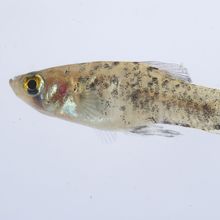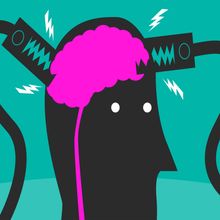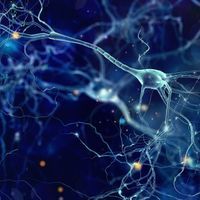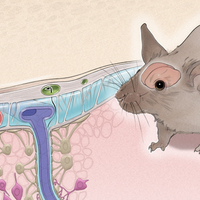Login
Subscribelearning and memory

Infographic: Two Guppy Brain Regions May Help Them Learn Tasks
Natalia Mesa, PhD | Nov 14, 2022 | 1 min read
While guppies with larger optic lobes were champions at learning visual discrimination tasks, guppies with larger telencephalons fared better when researchers switched things up.

Fish Brain Region Size Correlates with Cognitive Flexibility
Natalia Mesa, PhD | Nov 14, 2022 | 3 min read
The relative sizes of specific parts of the guppy brain may explain why some fish are better at learning certain tasks than others.

Famed Neuroscientist Charles Stevens Dies at 88
Lisa Winter | Nov 9, 2022 | 3 min read
His work blended biology and the methods of theoretical physics to explain neural networks.

Electrically Zapping Specific Brain Regions Can Boost Memory
Dan Robitzski | Aug 22, 2022 | 3 min read
Low-intensity electrical stimulation allows older adults to better recall a list of words for at least a month following the treatment, a study finds, providing further evidence for the debated idea that electrical stimulation can enhance cognitive performance.

Bacterial Metabolite May Regulate Cognition in Mice
Sophie Fessl, PhD | Jun 3, 2022 | 3 min read
Microbes in the gut influence the death of support cells in the brain by producing isoamylamine, a study suggests.

Distracted Brains Better at Parsing Unfamiliar Languages: Study
Catherine Offord | Apr 4, 2022 | 2 min read
People who had cognitive functions depleted by noninvasive brain stimulation or a mentally demanding task could subconsciously recognize individual words in a made-up language more easily than controls, researchers find.

Bacteria-Infecting Viruses in Gut Microbiome Linked to Cognition
Dan Robitzski | Feb 16, 2022 | 5 min read
Research in mice and flies suggests that bacteriophages, including those found in dairy foods, may have an influence on an animals’ ability to learn and remember information.

Neuroscientist Mortimer Mishkin Dies at 94
Lisa Winter | Oct 12, 2021 | 2 min read
His work bridged the gap between psychology and neurobiology.

Talking Duck Stuns Animal Behavior Researcher
Christie Wilcox, PhD | Sep 5, 2021 | 7 min read
Leiden University’s Carel ten Cate tracked down 34-year-old duck recordings—and the man who made them—to verify that musk ducks are capable of vocal learning, an ability that hadn’t been thought to exist in waterfowl.

Fecal Transplant Restores Youth to Old Mice
Roni Dengler, PhD | Aug 30, 2021 | 3 min read
Microbiota from young mice reversed some aspects of aging and enhanced brain health in aged mice.

Can Single Cells Learn?
Catherine Offord | May 1, 2021 | 10+ min read
A controversial idea from the mid-20th century is attracting renewed attention from researchers developing theories for how cognition arises with or without a brain.

Infographic: Investigating Whether Single Cells Learn
Catherine Offord | May 1, 2021 | 2 min read
Historical and modern experiments have hinted that unicelluar organisms can learn from their experiences, but the idea still has its critics.

Dietary Spermidine Boosts Cognition in Insects and Rodents
Ruth Williams | Apr 15, 2021 | 3 min read
Mice and flies given the polyamine in their diet have increased brain cell metabolism and cognitive function, and epidemiological data hints at a similar benefit in humans.

Early Training Forestalls Motor, Memory Difficulties in Mouse Model of Rett Syndrome
Laura Dattaro, Spectrum | Mar 29, 2021 | 3 min read
Manipulating the activity of neurons active during training had similar effects on the mice’s behavior.

Researchers Exchange Messages with Dreamers
Asher Jones | Feb 18, 2021 | 5 min read
Dreamers answered experimenters’ questions or solved simple math problems, showing that complex two-way communication between the dreaming and waking world is possible.

Scientists Engineer Dreams to Understand the Sleeping Brain
Catherine Offord | Dec 1, 2020 | 10+ min read
Technologies such as noninvasive brain stimulation and virtual reality gaming offer insights into how dreams arise and what functions they might serve.

Zebra Finches Recognize the Calls of Over 40 Fellow Finches
Amanda Heidt | Nov 13, 2020 | 5 min read
Their ability to distinguish between individuals is strong evidence for fast mapping, a learning tool generally thought to belong only to humans.

T Cells and Neurons Talk to Each Other
Ashley Yeager | Oct 1, 2020 | 10+ min read
Conversations between the immune and central nervous systems are proving to be essential for the healthy social behavior, learning, and memory.

Infographic: How Cytokines Flow into and out of the Brain
Ashley Yeager | Oct 1, 2020 | 2 min read
Several routes exist for immune cells to communicate with neurons in the central nervous system, though T cells rarely come in direct contact with neural tissue.
